-
WANTED: Happy members who like to discuss audio and other topics related to our interest. Desire to learn and share knowledge of science required. There are many reviews of audio hardware and expert members to help answer your questions. Click here to have your audio equipment measured for free!
You are using an out of date browser. It may not display this or other websites correctly.
You should upgrade or use an alternative browser.
You should upgrade or use an alternative browser.
Polk Signature Elite ES20 Review (Bookshelf Speaker)
- Thread starter amirm
- Start date
Maiky76
Senior Member
This is a review and detailed measurements of the Polk Signature Elite ES20 bookshelf speaker. I purchased it from Amazon for US $349 a pair including shipping.
View attachment 205739
I really like the look and finish of this series from Polk. Despite budget pricing, it looks nice and purposeful as you can tell from the unique rear port plate:
View attachment 205740
Measurements that you are about to see were performed using the Klippel Near-field Scanner (NFS). This is a robotic measurement system that analyzes the speaker all around and is able (using advanced mathematics and dual scan) to subtract room reflections (so where I measure it doesn't matter). It also measures the speaker at close distance ("near-field") which sharply reduces the impact of room noise. Both of these factors enable testing in ordinary rooms yet results that can be more accurate than an anechoic chamber. In a nutshell, the measurements show the actual sound coming out of the speaker independent of the room.
Measurements are compliant with latest speaker research into what can predict the speaker preference and is standardized in CEA/CTA-2034 ANSI specifications. Likewise listening tests are performed per research that shows mono listening is much more revealing of differences between speakers than stereo or multichannel.
Reference axis was the tweeter center. No grill was used. Measurement temperature was about 62 degrees F (17 degrees C).
Polk ES20 Measurements
Let's start with our usual "spinorama" graph:
View attachment 205741
On axis is reasonably good, marred by some resonances between 600 and 1000 Hz. And some unevenness in high treble area. There is a directivity dip around 4 kHz.
I forgot to note on the graph the deep bass extension. F10 is at nearly 35 Hz! This is partly due to a cabinet that is deeper than normal.
We see the cause of that roughness around 600 Hz in our near-field measurements:
View attachment 205742
We see more of a dip in directivity caused in vertical axis mostly:
View attachment 205743
Fortunately my listening room has a thick carpet and high ceilings so I will be hearing a more optimal off-axis response than averaged above.
Predicted in-room response with my custom trend line is thus:
View attachment 205745
I usually draw the trend line after my listening tests are completed and do in a manner that is consistent with that experience. See the next section.
I was impressed by the smooth and constant horizontal beam width and dispersion:
View attachment 205746
View attachment 205747
This also has wider than usual response which should create a more diffused field around the speaker (my preference).
Vertically we have the usual restrictions but again, the sweet spot is larger than I normally see in this class:
View attachment 205748
I like the low distortion especially at 86 dBSPL:
View attachment 205749
But notice how that resonance around 600 Hz is also showing up here in the form of distortion. This means that we will have impact beyond that frequency due to harmonics.
View attachment 205751
We see the same resonance in impedance graph and waterfall:
View attachment 205752
View attachment 205753
Finally for fans of timing tests, here are the impulse and step response:
View attachment 205754
View attachment 205755
Polk ES20 Listening Tests
My female starting track which lacks bass sounding a bit muddy/tubby and somewhat bright. So I brought out the EQ tool:
View attachment 205756
First filter was around 600 Hz. It is a small filter but per past experience, it not only removed a bit of muddiness but also reduced distortion. The latter caused the sound to be more open and clear. Once there, on tracks with good bass, the sound was more or less balanced. But with female tracks without such, it sounded too bright to me. A quick and dirty shelving filter fixed that nicely.
Once there, I was extremely impressed with the fidelity. Track after track sounded beautiful. Not only was the tonality right but there was this clarity and lack of distortion that kept impressing me. ES20 could play pretty loud and distorted gracefully in that the woofer just lost deep bass and became a tubby. Pull back a bit and you were golden.
Conclusions
I can see Polk having to both want to create an accurate speaker while working within strict budget and retain channel that demands "showroom sound." To that end, they have done a very good job here, producing bass response that is way above what you expect. And do so with very little distortion. The only issue is the port/cabinet resonance which makes the sound muddy and screws up upper bass a bit. And elevated treble which can be a bit much if bass response is not there. Fortunately both of these factors are excess output meaning EQ not only fixes them, but also reduces distortion. Result is a speaker and sound that you can really be proud of.
I can recommend the Polk Signature Elite ES20 as is but hugely so with equalization. You are getting so much performance for so little money.
-----------
As always, questions, comments, recommendations, etc. are welcome.
Any donations are much appreciated using: https://www.audiosciencereview.com/forum/index.php?threads/how-to-support-audio-science-review.8150/
Hi,
Here is my take on the EQ.
Please report your finding positive or negative!
The following EQs are “anechoic” EQs to get the speaker right before room integration. If you able to implement these EQs you must add EQ at LF for room integration, that is usually not optional… see hints there: https://www.audiosciencereview.com/...helf-speaker-review.11144/page-26#post-800725
The raw data with corrected ER and PIR:
Score no EQ: 4.7
With Sub: 6.6
Spinorama with no EQ:
- lots of resonances
- not great directivity
- Reasonably flat
Directivity:
Better stay at tweeter height
Horizontally, better toe-in the speakers by 10/20deg and have the axis crossing in front of the listening location, might help dosing the upper range.
EQ design:
I have generated two EQs. The APO config files are attached.
- The first one, labelled, LW is targeted at making the LW flat
- The second, labelled Score, starts with the first one and adds the score as an optimization variable.
- The EQs are designed in the context of regular stereo use i.e. domestic environment, no warranty is provided for a near field use in a studio environment although the LW might be better suited for this purpose.
with sub: 7.3
Score EQ Score: 5.9
with sub: 7.8
Code:
Polk ES200 APO EQ LW 96000Hz
May102022-182638
Preamp: -2.2 dB
Filter 1: ON HPQ Fc 44.80, 0.00, 1.20
Filter 2: ON PK Fc 113.09, -0.90, 1.34
Filter 3: ON PK Fc 649.19, -1.95, 4.75
Filter 4: ON PK Fc 1017.79, -1.16, 4.85
Filter 5: ON PK Fc 2156.62, 1.81, 0.77
Filter 6: ON PK Fc 3535.42, -1.47, 4.99
Filter 7: ON PK Fc 8574.03, 1.88, 4.87
Polk ES200 APO EQ Score 96000Hz
May102022-182432
Preamp: -2.7 dB
Filter 1: ON HPQ Fc 46.64, 0.00, 1.32
Filter 2: ON PK Fc 104.14, -1.17, 0.95
Filter 3: ON PK Fc 637.31, -3.23, 4.89
Filter 4: ON PK Fc 1012.22, -1.88, 4.85
Filter 5: ON PK Fc 2155.62, 1.81, 0.67
Filter 6: ON PK Fc 3534.42, -1.79, 4.99
Filter 7: ON PK Fc 6251.80, -1.61, 0.75
Filter 8: ON PK Fc 8464.23, 2.20, 4.41Spinorama EQ LW
Spinorama EQ Score
Zoom PIR-LW-ON
Regression - Tonal
Radar no EQ vs EQ score
Nice improvements
The rest of the plots is attached.
Attachments
-
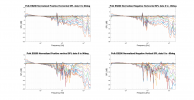 Polk ES200 Normalized Directivity data.png323.9 KB · Views: 98
Polk ES200 Normalized Directivity data.png323.9 KB · Views: 98 -
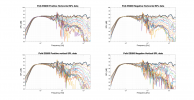 Polk ES200 Raw Directivity data.png494 KB · Views: 115
Polk ES200 Raw Directivity data.png494 KB · Views: 115 -
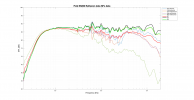 Polk ES200 Reflexion data.png144.5 KB · Views: 86
Polk ES200 Reflexion data.png144.5 KB · Views: 86 -
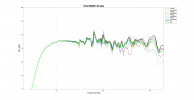 Polk ES200 LW data.png139.2 KB · Views: 108
Polk ES200 LW data.png139.2 KB · Views: 108 -
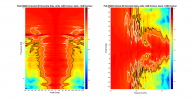 Polk ES200 2D surface Directivity Contour Data.png295.1 KB · Views: 93
Polk ES200 2D surface Directivity Contour Data.png295.1 KB · Views: 93 -
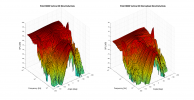 Polk ES200 3D surface Vertical Directivity Data.png453.4 KB · Views: 116
Polk ES200 3D surface Vertical Directivity Data.png453.4 KB · Views: 116 -
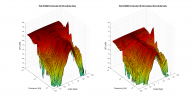 Polk ES200 3D surface Horizontal Directivity Data.png442.4 KB · Views: 105
Polk ES200 3D surface Horizontal Directivity Data.png442.4 KB · Views: 105 -
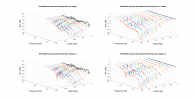 Polk ES200 Horizontal 3D Directivity data.png419.1 KB · Views: 108
Polk ES200 Horizontal 3D Directivity data.png419.1 KB · Views: 108 -
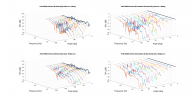 Polk ES200 Vertical 3D Directivity data.png431.5 KB · Views: 132
Polk ES200 Vertical 3D Directivity data.png431.5 KB · Views: 132 -
Polk ES200 APO EQ Score 96000Hz.txt429 bytes · Views: 119
-
Polk ES200 APO EQ LW 96000Hz.txt380 bytes · Views: 100
AudioSceptic
Major Contributor
No one seems to use the idea pioneered by Celef in the 70s, where the ports were filled with plastic drinking straws to provide resistance/damping for the air "slug" as it oscillates within the port. Or was that just a gimmick that didn't actually work?So many speakers have nasty upper mid resonances apparently caused by the port (can't speak of the boxes themselves buzzing along), yet others seem to avoid it. Got to say I wonder how this can be dealt with inexpensively?
- Joined
- Jan 15, 2020
- Messages
- 7,079
- Likes
- 17,820
That works, have seen it done in some DIY loudspeakers, probably not just very practical, robust and beautiful for an industrial product. As said nowadays there are also more elegant ways to reduce those problems.No one seems to use the idea pioneered by Celef in the 70s, where the ports were filled with plastic drinking straws to provide resistance/damping for the air "slug" as it oscillates within the port. Or was that just a gimmick that didn't actually work?
Shadrach
Addicted to Fun and Learning
- Joined
- Feb 24, 2019
- Messages
- 678
- Likes
- 986
Can you explain to me why this should have a higher preference rating to the KRK linked to below?Hi,
Here is my take on the EQ.
Please report your finding positive or negative!
The following EQs are “anechoic” EQs to get the speaker right before room integration. If you able to implement these EQs you must add EQ at LF for room integration, that is usually not optional… see hints there: https://www.audiosciencereview.com/...helf-speaker-review.11144/page-26#post-800725
The raw data with corrected ER and PIR:
Score no EQ: 4.7
With Sub: 6.6
View attachment 205813
Spinorama with no EQ:
- lots of resonances
- not great directivity
- Reasonably flat
Directivity:
Better stay at tweeter height
Horizontally, better toe-in the speakers by 10/20deg and have the axis crossing in front of the listening location, might help dosing the upper range.
View attachment 205827View attachment 205820
EQ design:
I have generated two EQs. The APO config files are attached.
Score EQ LW: 5.3
- The first one, labelled, LW is targeted at making the LW flat
- The second, labelled Score, starts with the first one and adds the score as an optimization variable.
- The EQs are designed in the context of regular stereo use i.e. domestic environment, no warranty is provided for a near field use in a studio environment although the LW might be better suited for this purpose.
with sub: 7.3
Score EQ Score: 5.9
with sub: 7.8
Code:Polk ES200 APO EQ LW 96000Hz May102022-182638 Preamp: -2.2 dB Filter 1: ON HPQ Fc 44.80, 0.00, 1.20 Filter 2: ON PK Fc 113.09, -0.90, 1.34 Filter 3: ON PK Fc 649.19, -1.95, 4.75 Filter 4: ON PK Fc 1017.79, -1.16, 4.85 Filter 5: ON PK Fc 2156.62, 1.81, 0.77 Filter 6: ON PK Fc 3535.42, -1.47, 4.99 Filter 7: ON PK Fc 8574.03, 1.88, 4.87 Polk ES200 APO EQ Score 96000Hz May102022-182432 Preamp: -2.7 dB Filter 1: ON HPQ Fc 46.64, 0.00, 1.32 Filter 2: ON PK Fc 104.14, -1.17, 0.95 Filter 3: ON PK Fc 637.31, -3.23, 4.89 Filter 4: ON PK Fc 1012.22, -1.88, 4.85 Filter 5: ON PK Fc 2155.62, 1.81, 0.67 Filter 6: ON PK Fc 3534.42, -1.79, 4.99 Filter 7: ON PK Fc 6251.80, -1.61, 0.75 Filter 8: ON PK Fc 8464.23, 2.20, 4.41
View attachment 205819
Spinorama EQ LW
View attachment 205814
Spinorama EQ Score
View attachment 205816
Zoom PIR-LW-ON
View attachment 205818
Regression - Tonal
View attachment 205817
Radar no EQ vs EQ score
Nice improvements
View attachment 205811
The rest of the plots is attached.

KRK ROKIT 5 Gen 4 Review (Studio Monitor)
These look like great desktop speakers As noted, floor (and ceiling) reflection are the issue here so put some absorber there or keep that path length long. Unfortunately in desktop application floor bounce is an issue as not many want or can place some absorbers on their desktop. Also with its...
 audiosciencereview.com
audiosciencereview.com
A shame about the port resonance as everything else looks great. I voted "Fine" just because of that, even considering the price.
Transmaniacon
Active Member
- Joined
- Mar 25, 2020
- Messages
- 185
- Likes
- 156
Good sounding speaker! I am loving my Polk R200s, glad to see their more budget options still performing very well.
DSJR
Major Contributor
Mission used this 'drinking straw technique' too and it definitely reduced the 'chuffing noises' of an undamped port tube. Other makers use foam lining to reduce turbulence, but so far, I haven't read anything about acknowledging the upper mid resonances so many ports add, let alone dealing with them. maybe the foam or drinking straws deal with this quite easily?No one seems to use the idea pioneered by Celef in the 70s, where the ports were filled with plastic drinking straws to provide resistance/damping for the air "slug" as it oscillates within the port. Or was that just a gimmick that didn't actually work?
beagleman
Major Contributor
Mission used this 'drinking straw technique' too and it definitely reduced the 'chuffing noises' of an undamped port tube. Other makers use foam lining to reduce turbulence, but so far, I haven't read anything about acknowledging the upper mid resonances so many ports add, let alone dealing with them. maybe the foam or drinking straws deal with this quite easily?
KEF addressed this, with a flexible portion in the middle of the port.
I think it varies a lot also, just based on factors that are not easily modified.
I read once that it is a "Partial" trade off of losing some bass response, versus a pipe resonance being somewhat higher in magnitude.
One of those things, that just come with the territory of vented speakers, but it can be varied but never eliminated based on the actual tube (Vent) resonating at some frequency.
I am not sure, but I also have heard the proliferation of smallish speakers with small vents, causes a lot of this issue. Larger boxes and larger vents do not suffer as much...
beagleman
Major Contributor
Polk Signature S-20
-> Better without bass-reflex back cover
He says he has "NO IDEA" what that cover does.
Without it, the port would be flat against a wall and blocked....was it that hard to imagine?
Maybe some tube connectors would fix that....

DSJR
Major Contributor
Got to respond in kind - I couldn't really see anything wrong with the crossover either - poly cap where necessary, air coils which I 'm sure are fine for the power handling, resistors the same and one electrolytic which again, should be fine for a ten plus year life and the extra resistance must be part of the crossover tuning?He says he has "NO IDEA" what that cover does.
Without it, the port would be flat against a wall and blocked....was it that hard to imagine?
Maybe some tube connectors would fix that....
If using a sub or two, I might remove that port cover and stuff the port.
See:Damped port slits will solve it.
beagleman
Major Contributor
Polk also had a "Cure" for the port issues, on several other models, they would have a front AND rear facing port(s) of different diameters, but tuned to the same Bass box frequency, supposedly the rear and front radiation, along with the different sized ports would reduce this issue.

Last edited:
Glitch
Member
Will using a curved pipe reduce higher mode port resonances?
What causes the resonances, is it more the port or the cabinet?
What causes the resonances, is it more the port or the cabinet?
See my last graph breaking down the score components, the SM_PIR is low, this is because it is a constant directivity design (as are many studio monitors), As such the off-axis in the treble shelves down instead of sloping down. This can lead to a bright sound when used in a living room sized setup; I do not know whether it is the best idea or not for studio use (Mr. Sprinkle designed JBL monitors with constant directivity but when he moved to Kali he did away with it and claimed doing so sounded better).Can you explain to me why this should have a higher preference rating to the KRK linked to below?

KRK ROKIT 5 Gen 4 Review (Studio Monitor)
These look like great desktop speakers As noted, floor (and ceiling) reflection are the issue here so put some absorber there or keep that path length long. Unfortunately in desktop application floor bounce is an issue as not many want or can place some absorbers on their desktop. Also with its...audiosciencereview.com
Also note that the score is not super valid for studio monitor use, as that is in the near/mid field, whereas the research was only done in far-field.
Last edited:
Hipster Doofus
Active Member
- Joined
- Sep 12, 2020
- Messages
- 271
- Likes
- 372
Hi all
as I always mention I an not a stero numbers guy but love good stuff. These reviews allow me to pick up knowledge and also get to the bottom line.
my thought today is home theater speakers, I have 3 listening rooms with good speakers for music and one happens to have my tv and Denon 960 in it. I run audyssey and all that but….
These Polks beg the following questions.( for just tv and movies)
1. what and where is the baseline and parameters for home theater surround? Some basics goals so to speak. We all like to upgrade and this area seems to be the easiest/cheapest and lots of fun as well.
2. Is it better to have the fronts and backs speakers be the same model number? talking 5.1 here.
3 is 7.1 really better then 5.1 and if so in what size room does it matter.
4 as with many speakers reviewed here they are great with that little eq tweak, can our audyssey do that vs Roon?
5. could there be a rating chart as there is for dacs, and amps and head phones or even an asterisk *
anyway hope this give us something to chew on
thanks in advance.
as I always mention I an not a stero numbers guy but love good stuff. These reviews allow me to pick up knowledge and also get to the bottom line.
my thought today is home theater speakers, I have 3 listening rooms with good speakers for music and one happens to have my tv and Denon 960 in it. I run audyssey and all that but….
These Polks beg the following questions.( for just tv and movies)
1. what and where is the baseline and parameters for home theater surround? Some basics goals so to speak. We all like to upgrade and this area seems to be the easiest/cheapest and lots of fun as well.
2. Is it better to have the fronts and backs speakers be the same model number? talking 5.1 here.
3 is 7.1 really better then 5.1 and if so in what size room does it matter.
4 as with many speakers reviewed here they are great with that little eq tweak, can our audyssey do that vs Roon?
5. could there be a rating chart as there is for dacs, and amps and head phones or even an asterisk *
anyway hope this give us something to chew on
thanks in advance.
Shadrach
Addicted to Fun and Learning
- Joined
- Feb 24, 2019
- Messages
- 678
- Likes
- 986
Thank you.See my last graph breaking down the score components, the SM_PIR is low, this is because it is a constant directivity design (as are many studio monitors), As such the off-axis in the treble shelves down instead of sloping down. This can lead to a bright sound when used in a living room sized setup; I do not know whether it is the best idea or not for studio use (Mr. Sprinkle designed JBL monitors with constant directivity but when he moved to Kali he did away with it and claimed doing so sounded better).
Also note that the score is not super valid for studio monitor use, as that is in the near/mid field, whereas the research was only done in far-field.
I did wonder how much influence listening distance had on the score.
I really need to take some time to properly understand how the preference score works.
Thanks again.
I really need to take some time to properly understand how the preference score works.

Speaker Equivalent SINAD Discussion
I thought I'd create a thread where suggestions/comments can be made on if Amir were to rank speakers based on measurements, how would he do so. As of right now, since Amir wants his rating to be based on listening tests and not just opinions, Sean Olive's Predicted Preference rating is likely...
 www.audiosciencereview.com
www.audiosciencereview.com
- Narrow Band Deviations of On-axis: Chunks the response into sections, averages the SPL of each section, within each section it sees how the SPL of the individual frequencies compares to the section average.
- Narrow Band Deviations of PIR: Same as above but for the PIR.
- r² (aka correlation squared) of PIR: Checks for a linear relationship (trend line) for the PIR; downside is wide vs narrow dispersion plays a role, where more slope (narrower dispersion) scores higher.
- Bass Extension: Self explanatory
While we don't have the 70 spinoramas & human response data, I'm willing to bet that if Olive just "normalized" the PIR to its own slope and did the PIR on that, that the preference rating would be more accurate. The reason to have #3 is that since the PIR most always has a slope, #2 won't score super high, as the avg SPL of the treble would be lower than the avg SPL of the midrange, so #3 is added to the formula to offset that (greater slope: lower NBD & higher SM ; lesser slope: higher NBD & lower SM), but the offset isn't great as it seems #3 changes more than #2 does.
Last edited:
Similar threads
- Replies
- 110
- Views
- 42K
- Replies
- 11
- Views
- 991
- Replies
- 9
- Views
- 2K
- Replies
- 37
- Views
- 17K
- Poll
- Replies
- 143
- Views
- 25K
